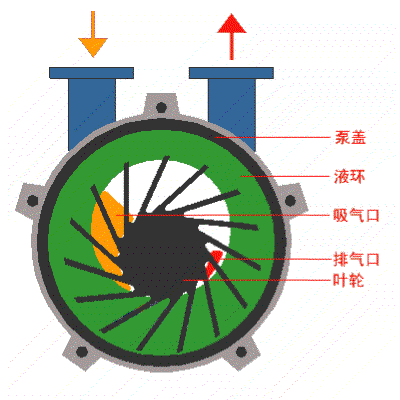
Principe de fonctionnement et caractéristiques de la pompe à vide à anneau d'eau/anneau liquide
2024-08-07 10:00Water ring vacuum pump (referred to as water ring pump) is a crude vacuum pump, which can obtain the limit vacuum of 2000~4000Pa, and the series atmospheric ejector can reach 270~670Pa. Water ring pump can also be used as a compressor, called water ring compressor, is a low-pressure compressor, its pressure range is 1~2×105Pa table pressure.
Water ring pumps were initially used as self-priming pumps, and then gradually used in many industrial sectors such as petroleum, chemical, machinery, mining, light industry, medicine and food. In many processes of industrial production, such as vacuum filtration, vacuum water diversion, vacuum feeding, vacuum evaporation, vacuum concentration, vacuum moisture return and vacuum degassing, water ring pump has been widely used. Due to the rapid development of vacuum application technology, water ring pump has been paid attention to in the field of crude vacuum acquisition. Because the gas compression in the water ring pump is isothermal, flammable and explosive gases can be pumped out, and gases containing dust and water can also be pumped out, so the application of water ring pump is increasing.

Figure: The pump body is filled with an appropriate amount of water as the working liquid. When the impeller rotates clockwise according to the figure, the water is thrown around by the impeller. Due to the action of centrifugal force, the water forms a closed ring of approximately equal thickness depending on the shape of the pump chamber. The inner surface of the lower part of the water ring is just tangent to the impeller hub, and the inner surface of the upper part of the water ring is just in contact with the tip of the blade (in fact, the blade has a certain insertion depth in the water ring). At this time, a crescent shaped space is formed between the impeller hub and the water ring, and this space is divided by the impeller into a number of small cavities equal to the number of blades. If the lower part of the impeller is 0° as the starting point, then the volume of the small cavity of the impeller increases from small to large when the impeller is 180° before rotation, and it is communicated with the suction port on the end face. At this time, the gas is inhaled, and the small cavity is isolated from the suction port when the suction ends. When the impeller continues to rotate, the small cavity is reduced from large to
small, so that the gas is compressed; When the small chamber communicates with the exhaust port, the gas is discharged out of the pump.
In summary, the water ring pump relies on the change of the volume of the pump chamber to achieve suction, compression and exhaust, so it belongs to the variable volume vacuum pump.
Compared with other types of mechanical vacuum pumps, water ring pumps have the following advantages:
1, simple structure, manufacturing precision requirements are not high, easy to process.
Compact structure, pump speed is high, generally can be directly connected with the motor, no deceleration device. Therefore, with a small structure size, you can obtain a large displacement and occupy a small area.
2, the compressed gas is basically isothermal, that is, the compressed gas process temperature changes very little.
Because there is no metal friction surface in the pump chamber, there is no need to lubricate the pump, and the wear is very small. The sealing between the rotating part and the fixed part can be done directly by the water seal.
3, suction uniform, stable and reliable work, simple operation, easy maintenance.
Water ring pumps also have their drawbacks
The efficiency is low, generally about 30%, and the best can reach 50%.
The low vacuum is not only limited by the structure, but more importantly by the saturated vapor pressure of the working fluid. With water as the working fluid, the limit pressure can only reach 2000~4000Pa. Oil as working fluid, up to 130Pa.
In short, because the gas compression in the water ring pump is isothermal, flammable and explosive gases can be pumped out. Since there is no exhaust valve and friction surface, it is possible to remove the gas with dust, condensable gas and gas water mixture. With these outstanding features, despite its low efficiency, it is still widely used.
